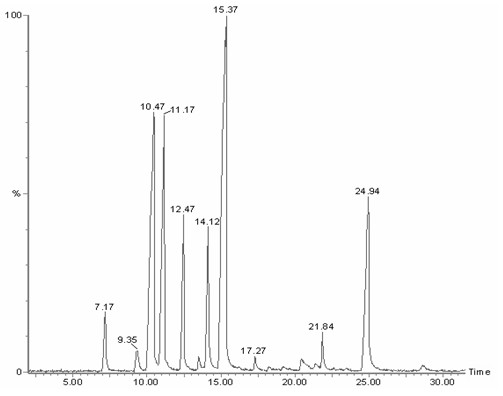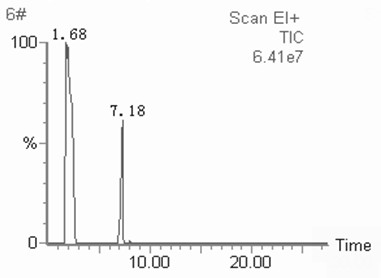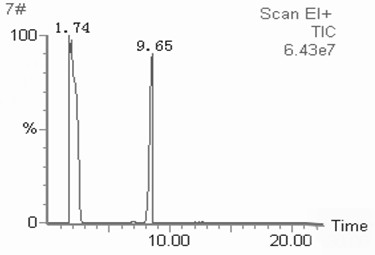Alpha-pinene extracted from pine needle, its extraction method and application for resisting tumor
An extraction method and technology of pinene, applied in α-pinene and its extraction method and its application in anti-tumor, can solve the problems of no obvious symptoms, lack of liver source, poor surgical effect, etc.
- Summary
- Abstract
- Description
- Claims
- Application Information
AI Technical Summary
Problems solved by technology
Method used
Image
Examples
Embodiment 1
[0024] Example 1 Extraction and purification of α-pinene
[0025] The tender stems and leaves of local pine needles were naturally dried in the shade, crushed to 40-60 mesh, and 200 g of pine needle powder was taken into a gauze bag by steam distillation, and extracted in a self-designed steam distillation device. Distill for 3 hours at a ratio of 1:8, take the upper essential oil, dissolve it with anhydrous ether, dry it with anhydrous sodium sulfate, and refrigerate for later use. The extracted pine needle oil is transparent yellowish liquid, pine needle oil of aromatic smell. We used the steam fractionation method to separate the pine needle oil from the pine needle extract, and obtained the main components of the pine needle oil as α-pinene and β-pinene, which were detected by high performance liquid phase, and the extraction purity reached 98% ( Figure 1~3 ).
Embodiment 2
[0026] Example 2 Study on the Anti-liver Cancer Effect and Mechanism of α-pinene
[0027] α-pinene can significantly inhibit the proliferation of liver cancer Bel7402 cells:
[0028] Use RPMT-1640 culture medium plus 10% calf serum, inoculate liver cancer 7402 cells in the above culture medium and place in CO 2 37°C in an incubator with 5% CO 2 Culture, digest and collect the cells in the logarithmic growth phase, and adjust the concentration to 5×10 7 / L single cell suspension, seeded in 96-well plate, 0.2ml per well, 24h later, add α-pinene prepared with RPMI-1640 culture medium, the final concentrations were: 8, 2, 0.5, 0.125, 0mg / L (blank control), the experimental groups of liver cancer cells treated with α-pinene at various concentrations, each group was inoculated into 8 replicate wells, placed in the incubator for 24, 48, and 72 h, and 20 μl of MTT solution was added to each well before the culture was terminated. Continue culturing for 4 hours, discard the cultu...
Embodiment 3
[0030] Liver cancer 7402 cells were treated with different concentrations (1:400, 1:600, 1:800, 1:1000) of α-pinene for different times (24h, 48h, 72h), the total RNA was extracted, and SYBR Green real-time fluorescent PCR was used Quantitative techniques were used to examine the expression changes of cell cycle regulatory genes cdc2, CdK1, p53, p21 and cyclinB1. Fluorescent quantitative PCR results showed that α-pinene could significantly down-regulate the expression of cdc25c mRNA in liver cancer Bel-7402 cells ( Figure 5 ).
PUM
 Login to View More
Login to View More Abstract
Description
Claims
Application Information
 Login to View More
Login to View More - R&D Engineer
- R&D Manager
- IP Professional
- Industry Leading Data Capabilities
- Powerful AI technology
- Patent DNA Extraction
Browse by: Latest US Patents, China's latest patents, Technical Efficacy Thesaurus, Application Domain, Technology Topic, Popular Technical Reports.
© 2024 PatSnap. All rights reserved.Legal|Privacy policy|Modern Slavery Act Transparency Statement|Sitemap|About US| Contact US: help@patsnap.com










